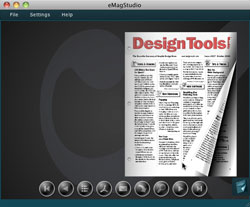eMagCreator 1.1

ELECTRONIC DOCUMENTS WITHOUT CODING
Every publisher wants his or her publications to be available electronically. Some publishers are happy with a searchable version that looks like the printed version. Other publishers want to add rich media, such as video, audio, RSS feeds, and Flash animations. Still others want interactivity, such as forms that readers can submit, and links to social media to let readers share their discoveries with others. Some magazine publishers even want to track their readers’ actions to find out what they read and what they click on.
Of course, there are many kinds of publishers and publications. While a simple PDF is sufficient for many purposes, once a publisher requires features beyond bookmarks and hyperlinks, a technical line is drawn—one that usually requires the advanced skills of an Acrobat or Flash expert.
eMagCreator 1.1 aims to put these powerful features into the hands of average knowledgeable workers, as well as to speed production of eMags by design and publishing professionals. The eMagCreator approach involves a standalone application for Mac and Windows that you use to convert your existing PDF into a rich-media, interactive Flash document. That document may then be viewed in a Web browser with the Adobe Flash plug-in installed, or as a standalone interactive document on a hard drive or file server. (Users of the Flashless iPhones and iPads may be satisfied by a parallel version of the eMag that doesn’t use Flash, but the eMag is stripped of its interactivity and rich media. At press time, this feature was in beta.)
Once you’ve chosen your existing PDF to be made into an eMag, there are three ways to proceed. The quickest is to use a template that adds a surrounding background and navigation bar to your PDF, then publishes it as a SWF (Flash) file. Your readers will see your PDF on a standardized background and color scheme, with navigation buttons and the ability to flip the pages back and forth.
For more control when creating your eMag, you can use a step-by-step wizard to assign appearances, choose navigation buttons, and more. But for the most control, you’ll want to use the Toolbox to either build an eMag from pieces, or to add content to an eMag created by one of the simpler methods.
You can then make important edits and add hyperlinks to page areas by dragging them—URLs, mail links, and custom FTP links are supported. You can also add animated effects to page elements, including mouseover behaviors for hyperlinks and tooltips, and choose whether to allow printing of pages.
eMagCreator is offered in three versions: QuickMag ($699 plus Service Pack; tested), Lifetime ($2,400 plus Service pack), and Enterprise (from $4,500).The annual Service Pack fee costs $899 for the Pro version, and $1,099 for the Reseller version. The two higher versions include an online eMag Studio Portal that gives you live reader statistics to share with your clients (or not). You can see a graph of each eMag’s viewership compared to others and, within an eMag, you can see which pages were viewed and zoomed into the most, what readers have searched for, which links were activated, how often the eMag was forwarded to other readers, etc.
And that one feature, in my opinion, is the biggest reason to use this product. Yes, being able to standardize the appearance of your eMag documents for your corporate identity is important. Allowing average workers to create eMags is empowering and valuable. But tracking user actions can dramatically improve the direction of a publication and increase its revenue by understanding reader response to its editorial and advertising content.—Jay Nelson
Company: Papeer North America Inc.
Price: $699 (plus Service Pack)
Web: www.emagcreator.com
Rating: 4
Hot: Reader statistics tracking; ease of use
Not: Processor overhead for Flash; iPhone and iPad support; annual fee
